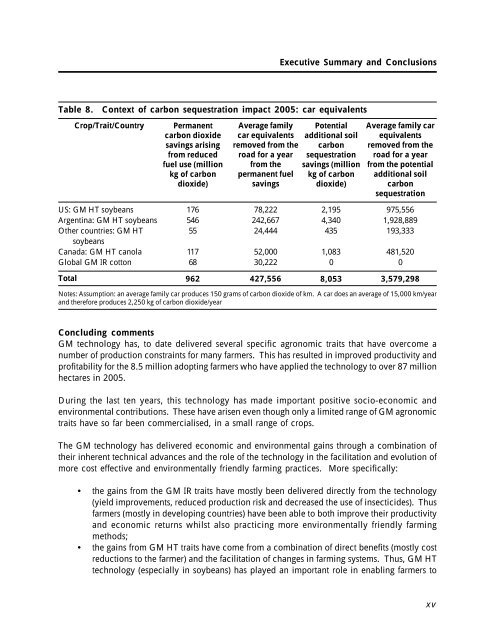GM Crops: The First Ten Years - International Service for the ...
GM Crops: The First Ten Years - International Service for the ...
GM Crops: The First Ten Years - International Service for the ...
Create successful ePaper yourself
Turn your PDF publications into a flip-book with our unique Google optimized e-Paper software.
Table 8. Context of carbon sequestration impact 2005: car equivalents<br />
Crop/Trait/Country<br />
US: <strong>GM</strong> HT soybeans<br />
Argentina: <strong>GM</strong> HT soybeans<br />
O<strong>the</strong>r countries: <strong>GM</strong> HT<br />
soybeans<br />
Canada: <strong>GM</strong> HT canola<br />
Global <strong>GM</strong> IR cotton<br />
Permanent<br />
carbon dioxide<br />
savings arising<br />
from reduced<br />
fuel use (million<br />
kg of carbon<br />
dioxide)<br />
176<br />
546<br />
55<br />
117<br />
68<br />
Average family<br />
car equivalents<br />
removed from <strong>the</strong><br />
road <strong>for</strong> a year<br />
from <strong>the</strong><br />
permanent fuel<br />
savings<br />
78,222<br />
242,667<br />
24,444<br />
52,000<br />
30,222<br />
Executive Summary and Conclusions<br />
Potential<br />
additional soil<br />
carbon<br />
sequestration<br />
savings (million<br />
kg of carbon<br />
dioxide)<br />
2,195<br />
4,340<br />
435<br />
1,083<br />
0<br />
Average family car<br />
equivalents<br />
removed from <strong>the</strong><br />
road <strong>for</strong> a year<br />
from <strong>the</strong> potential<br />
additional soil<br />
carbon<br />
sequestration<br />
975,556<br />
1,928,889<br />
193,333<br />
481,520<br />
0<br />
Total 962 427,556 8,053 3,579,298<br />
Notes: Assumption: an average family car produces 150 grams of carbon dioxide of km. A car does an average of 15,000 km/year<br />
and <strong>the</strong>re<strong>for</strong>e produces 2,250 kg of carbon dioxide/year<br />
Concluding comments<br />
<strong>GM</strong> technology has, to date delivered several specific agronomic traits that have overcome a<br />
number of production constraints <strong>for</strong> many farmers. This has resulted in improved productivity and<br />
profitability <strong>for</strong> <strong>the</strong> 8.5 million adopting farmers who have applied <strong>the</strong> technology to over 87 million<br />
hectares in 2005.<br />
During <strong>the</strong> last ten years, this technology has made important positive socio-economic and<br />
environmental contributions. <strong>The</strong>se have arisen even though only a limited range of <strong>GM</strong> agronomic<br />
traits have so far been commercialised, in a small range of crops.<br />
<strong>The</strong> <strong>GM</strong> technology has delivered economic and environmental gains through a combination of<br />
<strong>the</strong>ir inherent technical advances and <strong>the</strong> role of <strong>the</strong> technology in <strong>the</strong> facilitation and evolution of<br />
more cost effective and environmentally friendly farming practices. More specifically:<br />
• <strong>the</strong> gains from <strong>the</strong> <strong>GM</strong> IR traits have mostly been delivered directly from <strong>the</strong> technology<br />
(yield improvements, reduced production risk and decreased <strong>the</strong> use of insecticides). Thus<br />
farmers (mostly in developing countries) have been able to both improve <strong>the</strong>ir productivity<br />
and economic returns whilst also practicing more environmentally friendly farming<br />
methods;<br />
• <strong>the</strong> gains from <strong>GM</strong> HT traits have come from a combination of direct benefits (mostly cost<br />
reductions to <strong>the</strong> farmer) and <strong>the</strong> facilitation of changes in farming systems. Thus, <strong>GM</strong> HT<br />
technology (especially in soybeans) has played an important role in enabling farmers to<br />
xv
















